Process control statement
In the process of a program execution, the execution order of each statement has a direct impact on the result of the program. Therefore, we must know the execution process of each statement. Moreover, we often need to control the execution order of statements to achieve the functions we want. Process control statements are classified as follows:
- Sequential structure
- Branch structure (if, switch)
- Loop structure (for, while, do... while)
Sequential structure
Sequential structure is the simplest and most basic process control in the program. There is no specific syntax structure. It is executed in sequence according to the sequence of codes. Most codes in the program are executed in this way.
Sequential structure execution flow chart:

Code example
public class Demo { public static void main(String[] args) { System.out.println(1); System.out.println(2); System.out.println(3); System.out.println(4); System.out.println(5); } }
Branching structure
Execute different statements according to different conditions. In Java, the branch structure can be divided into if statement and Switch statement.
if statement format
Format:

Execution process:
- First, evaluate the value of the relationship expression
- If the value of the relational expression is true, the statement body is executed
- If the value of the relational expression is false, the statement body is not executed
- Continue to execute the following statements
Execution flow chart
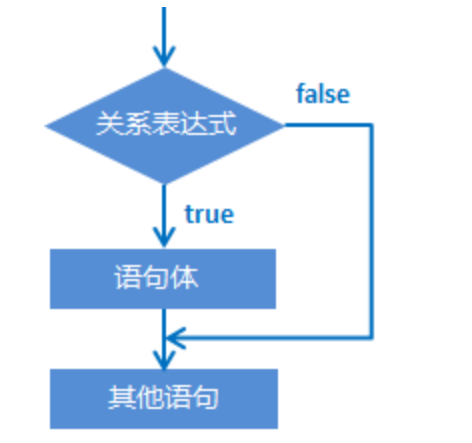
Code example
public class Demo { public static void main(String[] args) { System.out.println("start"); int age = 17; // If older than 18, You can go to the Internet bar if(age >= 18){ // age > 18 by true Body of statement executed System.out.println("You can go to Internet cafes"); } System.out.println("end"); } }
If... Else of if statement format
Format:
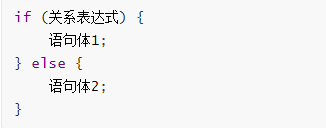
Execution process:
- First, evaluate the value of the relationship expression
- If the value of the relational expression is true, the statement body 1 is executed
- If the value of the relational expression is false, statement body 2 is executed
- Continue to execute the following statements
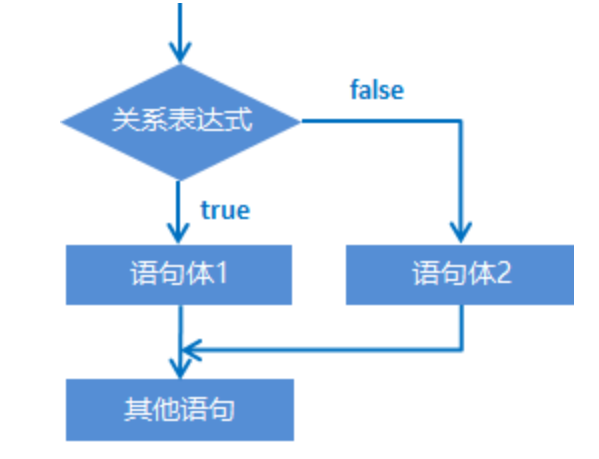
Code example
public class Demo { public static void main(String[] args) { // The program judges a number, Is it odd or even int num = 9; if(num % 2 == 0){ System.out.println("even numbers"); }else{ System.out.println("Odd number"); } } }
If... Else in if statement format
format
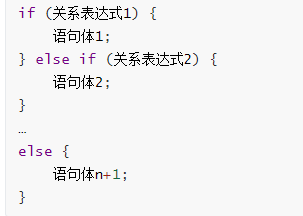
Execution process:
- First, evaluate the value of relationship expression 1
- If the value is true, execute statement body 1; If the value is false, the value of relationship expression 2 is evaluated
- If the value is true, execute statement body 2; If the value is false, the value of relationship expression 3 is evaluated
- ...
- If no relational expression is true, the statement body n+1 is executed.
Execution flow chart
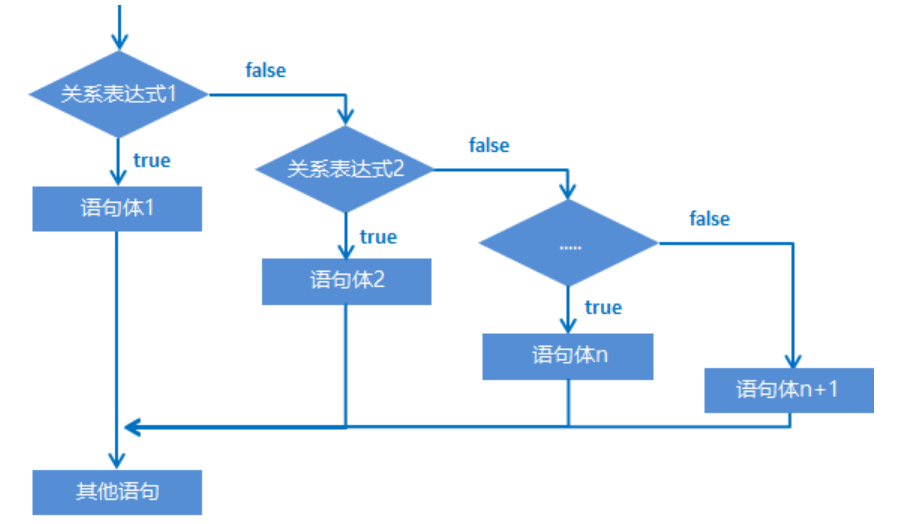
Code example
import java.util.Scanner; /* Demand: Xiaoming is about to take the final exam. Xiaoming's father told him that he would give him different gifts according to his different test scores If you can control Xiao Ming's score, please use the program to realize what kind of gift Xiao Ming should get and output it on the console. */ public class Demo { public static void main(String[] args) { // 1. use Scanner Enter test scores Scanner sc = new Scanner(System.in); System.out.println("Please enter your grade:"); int score = sc.nextInt(); // 2. Judge whether the score is within the legal range 0~100 if (score >= 0 && score <= 100) { // Legal achievement // 3. In the legal sentence block, judge which reward the score range meets if (score >= 95 && score <= 100) { System.out.println("A bicycle"); } else if (score >= 90 && score <= 94) { System.out.println("Amusement park once"); } else if (score >= 80 && score <= 89) { System.out.println("Transformers one"); } else { System.out.println("Get beaten up, There is another sad man in this city~"); } } else { // Illegal words, Give error prompt System.out.println("Your score is entered incorrectly!"); } } }
matters needing attention:
- If the statement body controlled by the if statement is a statement, it can be omitted, but it is strongly recommended not to write!
switch statement of branch statement
Format:
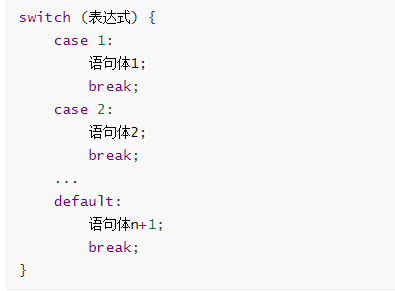
Execution process:
- First, calculate the value of the expression
- Secondly, compare with case in turn. Once there is a corresponding value, the corresponding statement will be executed, and the break will end in the process of execution.
- Finally, if all case s do not match the value of the expression, the body of the default statement is executed, and the program ends.
Sample code
import java.util.Scanner; public class TestSwitch { /* Demand: enter the number of weeks on the keyboard to display today's weight loss activities. Monday: running Tuesday: swimming Wednesday: walk slowly Thursday: spinning Friday: Boxing Saturday: mountain climbing Sunday: have a good meal analysis: 1. Enter the week data with the keyboard and receive it with variables 2. Multi case judgment is realized by switch statement 3. In different case s, output the corresponding weight loss plan */ public static void main(String[] args){ // 1. Enter the week data with the keyboard and receive it with variables Scanner sc = new Scanner(System.in); System.out.println("Please enter"); int week = sc.nextInt(); // 2. Multi case judgment, using switch Statement implementation switch(week){ // 3. In different case Output the corresponding weight loss plan case 1: System.out.println("run"); break; case 2: System.out.println("Swimming"); break; case 3: System.out.println("Walk slowly"); break; case 4: System.out.println("Spinning bike"); break; case 5: System.out.println("Boxing"); break; case 6: System.out.println("Mountain climbing"); break; case 7: System.out.println("Have a good meal"); break; default: System.out.println("Your input is incorrect"); break; } } }
switch statement case penetration
Overview: if the break statement is omitted from the case in the switch statement, case penetration will begin
Sample code
import java.util.Scanner; public class Demo { /* Requirement: enter the number of weeks on the keyboard and output working days and rest days (1-5)Working days, (6-7) rest days case How does penetration occur? If case omits the break statement in the switch statement, case penetration will begin Phenomenon: When case penetration starts, subsequent cases will not have matching effect, and internal statements will be executed It will not end until you see the break or finish executing the overall switch statement. */ public static void main(String[] args){ Scanner sc = new Scanner(System.in); System.out.println("Please enter the number of weeks:"); int week = sc.nextInt(); switch(week){ case 1: case 2: case 3: case 4: case 5: System.out.println("weekdays"); break; case 6: case 7: System.out.println("Rest Day"); break; default: System.out.println("Your input is incorrect"); break; } } }
Cyclic structure
A loop statement can repeatedly execute a piece of code when the loop conditions are met. This repeatedly executed code is called a loop body statement. When the loop body is repeatedly executed, the loop judgment condition needs to be modified to false at an appropriate time to end the loop, otherwise the loop will be executed all the time and form a dead loop. In general, the composition of the cycle is as follows:
- Initialization statement: used to indicate the starting state when the loop is opened. In short, it is what it looks like when the loop starts
- Condition judgment statement: used to indicate the condition of repeated execution of the loop. In short, it is used to judge whether the loop can be executed all the time
- Loop body statement: used to represent the content of loop repeated execution, which is simply the matter of loop repeated execution
- Conditional control statement: used to represent the contents of each change in the execution of the loop. In short, it controls whether the loop can be executed
for loop of loop statement
for loop format:

Execution process:
- Execute initialization statement
- Execute the conditional judgment statement to see whether the result is true or false. If false, the loop ends. If true, continue
- Execute loop body statement
- Execute conditional control statements
- Go back to ② continue
Code example
//Output all "daffodils" on the console. Narcissus number refers to a three digit number. The sum of the number cubes of one digit, ten digit and hundred digit is equal to the original number public class Demo { /* Requirement: output all "daffodils" on the console. It is required to print 2 per line System.out.print (Print content); Do not wrap after printing System.out.println(Print content); Wrap after printing analysis: 1. Define the variable count, which is used to save the "printed" quantity. The initial value is 0 2. In the process of determining and printing the number of daffodils, splice spaces without line breaks, and let the count variable + 1 after printing to record the printed quantity 3. After each count variable + 1, judge whether it reaches the multiple of 2. If yes, wrap the line. */ public static void main(String[] args) { // 1. Define variables count,It is used to save the quantity of "printed", and the initial value is 0 int count = 0; for (int i = 100; i <= 999; i++) { int ge = i % 10; int shi = i / 10 % 10; int bai = i / 10 / 10 % 10; if ((ge * ge * ge + shi * shi * shi + bai * bai * bai) == i) { // 2. In the process of determining and printing the number of daffodils, splice spaces, But do not wrap lines, and let count variable+1,Record the printed quantity System.out.print(i + " "); count++; // 3. Every time count variable+1 After that, judge whether it has reached the multiple of 2. If yes, wrap the line if (count % 2 == 0) { System.out.println(); } } } } }
Summary: in the future, if the demand has statistics xxx, please think of the counter variable first. The position defined by the counter variable must be outside the loop
while loop of loop statement
while loop full format

while loop execution process:
- Execute initialization statement
- Execute the conditional judgment statement to see whether the result is true or false. If false, the loop ends. If true, continue
- Execute loop body statement
- Execute conditional control statements
- Go back to ② continue
Sample code
/* The highest mountain in the world is Mount Everest (8844.43 M = 8844430 mm). If I had a large enough paper, Its thickness is 0.1 mm. How many times can I fold it to the height of Mount Everest? */ public class Demo { public static void main(String[] args) { //Define a counter with an initial value of 0 int count = 0; //Define paper thickness double paper = 0.1; //Defines the height of Mount Everest int zf = 8844430; //Because it needs to be folded repeatedly, it is necessary to use the cycle, but do not know how many times to fold, which is more suitable for use in this case while loop //The folding process stops when the paper thickness is greater than Everest, so the requirement to continue is that the paper thickness is less than Everest height while(paper <= zf) { //During the execution of the cycle, the thickness of the paper shall be doubled each time the paper is folded paper *= 2; //How many times is the accumulation performed in the loop folded count++; } //Print counter value System.out.println("Folding required:" + count + "second"); } }
dowhile loop of loop statement
Full format:

Execution process:
- Execute initialization statement
- Execute loop body statement
- Execute conditional control statements
- Execute the conditional judgment statement to see whether the result is true or false. If false, the loop ends. If true, continue
- Go back to ② continue
Code example
public class Demo { //Requirement: output 5 times on the console"HelloWorld" public static void main(String[] args) { //do...while Loop implementation int j = 1; do { System.out.println("HelloWorld"); j++; } while (j <= 5); } }
The difference between the three cycles
- for loop and while loop first judge whether the condition is true, and then decide whether to execute the loop body (judge first and then execute)
- The do...while loop executes the loop body once, and then judges whether the condition is true and whether to continue to execute the loop body (execute first and then judge)
The difference between a for loop and a while loop
- The self increasing variable controlled by the conditional control statement cannot be accessed again after the for loop ends because it belongs to the syntax structure of the for loop
- The self increasing variable controlled by the conditional control statement does not belong to its syntax structure for the while loop. After the while loop ends, the variable can continue to be used
Dead cycle
Format:
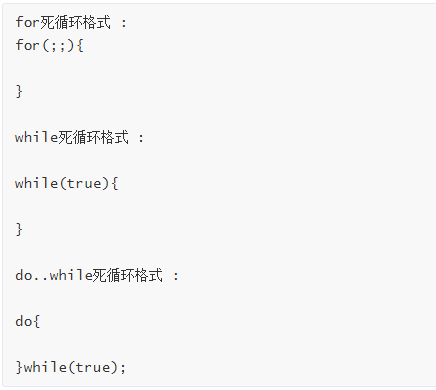
be careful: Inaccessible statements cannot be written, otherwise an error will be reported
Jump control statement
Jump control statement (break)
Jump out of the loop and end the loop
public class Demo { /* break : Terminate execution of loop body content Note: use is conditional break Statements can only be used in loops and switch es Demand: simulate working from 20 to 80 and retiring at 60 */ public static void main(String[] args){ for(int i = 20; i <= 80; i++){ if(i == 60){ break; // End the whole cycle } System.out.println(i + "I'm at work"); } } }
Jump control statement (continue)
Skip this cycle and continue with the next cycle
public class Demo { /* continue : Skip execution of a loop body Note: use is based on condition control and is used inside the loop Demand: simulate the process of elevator ascending, 1-24 floors, 4 floors non-stop */ public static void main(String[] args){ for(int i = 1; i <= 24; i++){ if(i == 4){ continue; } System.out.println(i + "Here we are~"); } } }
Comprehensive exercise
import java.util.Scanner; import java.util.Random; public class Test { /* Requirements: the program automatically generates a number between 1 and 100. Use the program to guess what the number is? When you guess wrong, give corresponding tips according to different situations If the guessed number is larger than the real number, it indicates that the guessed data is larger If the guessed number is smaller than the real number, it indicates that the guessed data is smaller If the number you guessed is equal to the real number, you will be prompted to congratulate you on your correct guess 1. Prepare Random and Scanner objects for generating Random numbers and keyboard entry respectively 2. Use Random to generate a number between 1 and 100 as the number to guess 3. Enter the data guessed by the user with the keyboard 4. Use the entered data (the data guessed by the user) and random number (the data to be guessed) to compare and give a prompt 5. The above contents need to be carried out many times, but it is impossible to predict how many times the user inputs. You can guess correctly and use the while(true) dead loop package 6. After you guess right, break ends */ public static void main(String[] args){ // 1. prepare Random and Scanner object, It is used for generating random numbers and keyboard entry respectively Random r = new Random(); Scanner sc = new Scanner(System.in); // 2. use Random Generate a 1-100 Number between, As the number to guess int randomNum = r.nextInt(100) + 1; // 5. The above contents need to be repeated, However, it is impossible to predict how many times the user enters, and you can guess correctly, use while(true)Dead circulation package while(true){ // 3. Enter the data guessed by the user with the keyboard System.out.println("Please enter the data you guessed:"); int num = sc.nextInt(); // 4. Use the entered data(User guessed data)Random number(Data to guess)Compare, And give tips if(num > randomNum){ System.out.println("Guess big"); }else if(num < randomNum){ System.out.println("Guess it's small"); }else{ // 6. After you guessed right, break end. System.out.println("congratulations,You guessed right"); break; } } System.out.println("Thank you for your use"); } }